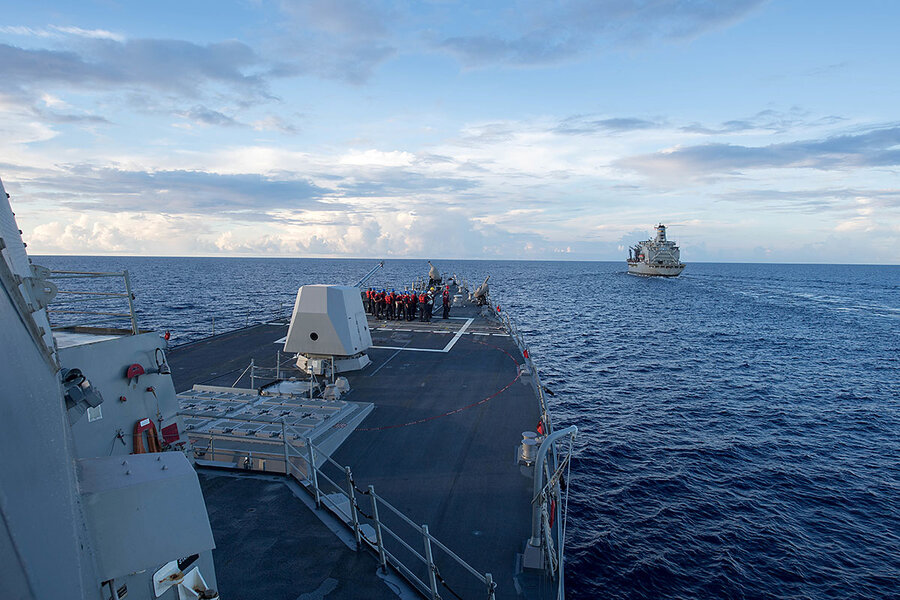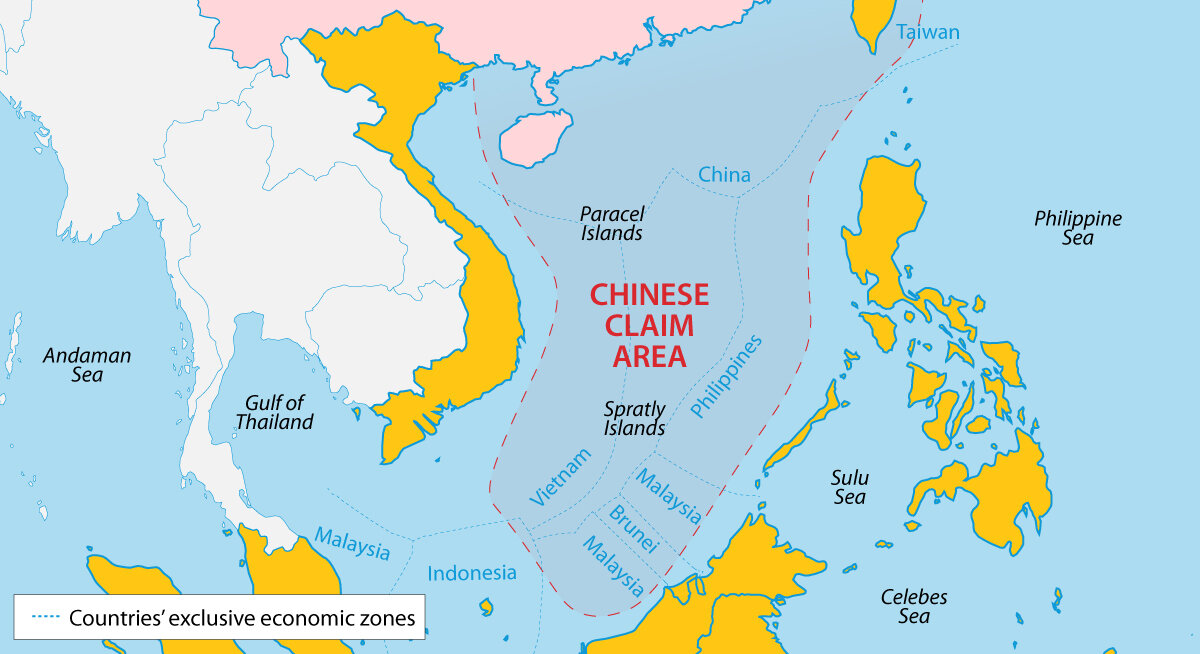US patrol sends signal to Beijing's claims in South China Sea – but how strong?
Loading...
| Beijing
Fifteen years ago, when China and the 10-country Association of Southeast Asian Nations committed to establishing a code of conduct to govern actions in the South China Sea, the Paracel Islands were little more than a collection of rocks 138 miles off the coast of Vietnam.
They’re now home to Chinese harbors, helipads, and an air base. Last year, Beijing deployed anti-aircraft missiles to the archipelago. And satellite images released earlier this year by Center for Strategic and International Studies in Washington show that more work is being done in likely preparation for further construction.
China’s militarization of the South China Sea, a vast waterway through which more than $5 trillion in trade passes each year, faced sharp criticism from the Obama administration, which regularly ordered freedom-of-navigation patrols to challenge Beijing’s territorial claims in the area.
Having criticized former President Obama for not doing enough to counter China, Donald Trump took over the White House seeming eager to up the pressure. For the first four months his presidency, however, it looked as if the US had decided to back off, perhaps seeking Beijing’s cooperation on North Korea or other concessions on issues such as trade. That appeared to change on Wednesday, when a US Navy destroyer sailed within 12 miles of one of China's man-made islands in Mischief Reef, in the Spratly Islands.
The patrol, the first of its kind since October, marks the Trump administration’s first public foray into the South China Sea dispute. But analysts say it’s far from enough to alleviate concerns among US allies that the White House is unwilling to confront China on the issue – or diminish Beijing’s efforts to expand its influence in the region.
“The operation sends a long overdue signal in the South China Sea that the United States does not recognize China's spurious claims to water and air space around its artificial islands,” says Mira Rapp-Hooper, a senior fellow in the Asia-Pacific Security Program at the Center for a New American Security in Washington. “But this administration is going to have to do more than just conduct a single passage with one naval vessel to convince Southeast Asian nations that it's invested in freedom of navigation over the long haul.”
New code of conduct
For now, Dr. Rapp-Hooper says, China will keep arming its artificial islands while pushing ahead on the diplomatic front. The country’s latest diplomatic breakthrough came last Thursday, when it reached an agreement with the Association of Southeast Asian Nations (ASEAN) on a draft code of conduct in the disputed waterway. Details of the draft weren't disclosed, but the framework agreement came as a sign of progress after 15 years of stalled negotiations. It will next be presented to Chinese and ASEAN foreign ministers in August for consideration.
Rapp-Hooper says the code of conduct is far from a done deal and that there is likely much left to negotiate. Still, she says the timing of last week’s announcement signals China’s push to reinforce its position in the South China Sea at a time when US policy for the region remains unclear.
“China is basically now in a position to consolidate its gain,” Rapp-Hooper says. “It’s built what it wanted to build. Now it can use the code of conduct to say to the other South China Sea claimants, ‘We know it’s been a rough few years, but we’re willing to play ball now.’ ”
Analysts say Beijing’s ultimate goal is to pull Southeast Asian nations closer into its orbit, disrupting the post-World War II order that paved the way for the US to become a dominant power in Asia. In the short term, Beijing wants to prevent Washington from influencing its negotiations with other countries that border the South China Sea. China claims virtually the entire sea, while the Philippines, Malaysia, Brunei, Vietnam, and Taiwan claim parts.
Last July, an international tribunal at The Hague's Permanent Court of Arbitration concluded that China's claims to wide-reaching sovereignty over the sea had no legal basis, although Beijing boycotted the proceedings and rejected the decision. The case was brought by the Philippines under former President Benigno Aquino III, but his successor, President Rodrigo Duterte, has downplayed the tribunal's decision as he pursues stronger ties with China.
“History and facts have proven that countries in the region are fully capable of handling the South China Sea issue themselves,” Xinhua, China’s state news agency, said in a commentary on Monday. “Any outside noise should be drowned out.”
Balancing act
Much to the delight of Beijing, the Trump administration hadn’t made much noise until Wednesday. Previously, the administration’s strongest criticism came during Secretary of State Rex Tillerson’s confirmation hearing, when he suggested that China should be denied access to the islands it built. Despite his harsh words, the Pentagon later turned down three requests from the US Pacific Command to conduct freedom-of-navigation patrols (FONOPS), The New York Times reports.
A statement from Pentagon spokesman Maj. Jamie Davis gave no details of recent patrols, but said that “US forces operate in the Asia-Pacific region on a daily basis, including in the South China Sea. All operations are conducted in accordance with international law and demonstrate that the United States will fly, sail, and operate wherever international law allows.”
“FONOPS are not about any one country, nor are they about making political statements.”
Carlyle Thayer, an emeritus professor at the University of New South Wales in Australia, says the prolonged suspension of freedom-of-navigation operations fueled concerns that the US would stop trying to counter China’s growing influence in the region. Without support from the US, smaller countries could begin to see China as the region’s most dependable power. Regional dynamics are already shifting, such as Mr. Duterte's pivot toward China while distancing the Philippines from the US, a longtime ally.
“China’s line is that the US should not interfere [or] disrupt China-ASEAN diplomacy,” Dr. Thayer says in an email. And with the Trump administration’s protracted show of deference toward Beijing, he adds, it was “going along quite well.”
After this week's patrol, however, Chinese officials said they had lodged a complaint.
“We urge the US to correct this mistake and stop taking further actions so as to avoid hurting peace and security in the region and long-term cooperation between the two countries,” said Lu Kang, a spokesman for the Foreign Ministry.
China is a long way from displacing the US from the South China Sea or Southeast Asia, says Tiffany Ma, senior director of political and security affairs at the National Bureau of Asian Research in Washington. For one thing, the US still maintains a large military presence in the region. In January, the Philippine defense ministry announced the US would upgrade facilities at military bases across the country this year, although Duterte had previously called for some US troops to leave.
“This is a balancing act countries in Southeast Asia have been walking for a long time,” Ms. Ma says. “The broader question is whether the US is committed to maintaining the post-World War II order that has come to define the region.”
Editor's note: This story has been updated to clarify which legal body heard the case over China's claims in the South China Sea. It was an international tribunal at the Permanent Court of Arbitration, in The Hague.






